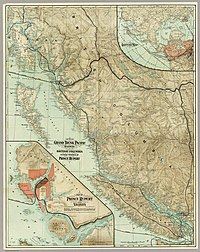Grand Trunk Pacific Railway
 |
|
 |
|
| Reporting mark | GTP |
|---|---|
| Locale | Ontario, Manitoba, Saskatchewan, Alberta, British Columbia |
| Dates of operation | 1914–1920 |
| Successor | Canadian National Railway |
| Track gauge | 4 ft 8 1⁄2 in (1,435 mm) standard gauge |
The Grand Trunk Pacific Railway (reporting mark GTP) was a historical Canadian transcontinental railway running from Winnipeg to the Pacific coast at Prince Rupert, British Columbia. East of Winnipeg the line continued as the National Transcontinental Railway (NTR), running across northern Ontario and Quebec, crossing the St. Lawrence River at Quebec City and ending at Moncton, New Brunswick. The entire line was managed and operated by Grand Trunk Railway (GTR).
The GTP was the result of the Government of Canada's desire for a northerly transcontinental route in order to open up new areas of the prairies that were becoming economically valuable with the introduction of new species of cereal grains. The CPR and CNoR both ran southern routes along the Canada–US border in order to serve existing markets as well as US shipping. GTR had been approached on several occasions to build the original "Canadian Pacific Survey" route through Yellowhead Pass, but declined because they felt the traffic would be too low. Increased pressure from the Wilfrid Laurier administration led to the company agreeing to build only the western section, funded entirely by government loans, while the eastern sections would be left to the government to build as the NTR.
Construction began in 1905 and was completed by 1913. By 1914 it was clear there was not enough traffic to pay for the line, and in a war measure the section between Edmonton and Jasper was leased from the CNoR, and the GTP's rails through this section were lifted and sent to France to construct new railways there. In 1918, CNoR failed and was nationalized as the Canadian National Railways, and the GTP followed suit in 1920. A number of GTP subdivisions remain in use as part of the CN mainlines, while others have been abandoned and lifted starting in the 1980s.
...
Wikipedia
